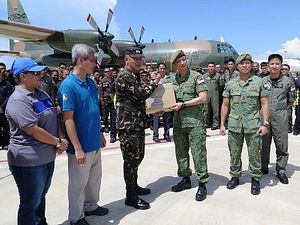Over the weekend, during remarks at the National Defense College of the Philippines (NDCP), Philippine Defense Secretary Delfin Lorenzana dwelled a little on the increased capability requirements that the Armed Forces of the Philippines (AFP) is looking for, particularly in the intelligence realm, as it confronts Islamic State-linked militants in the southern city of Marawi. Lorenzana’s comments are yet another indication of the challenges that the Southeast Asian state continues to face as it deals with a rising terror threat.
As I noted last week, the AFP has struggled during the Marawi crisis that began on May 23, and that has not been surprising to those familiar with both the general challenges it faces as well as the specifics of the current situation. The AFP remains one of the region’s weakest militaries despite some improvements, and Marawi has been an uphill battle for it because of various factors including the fact that it is a densely populated city with dense, forested terrain outside of it, and the reality that the allegiances between various insurgent groups and foreign fighters can be much looser than the headlines often suggest (See: “Why Has the Philippines’ Military Struggled in its Terror Fight Under Duterte?”).
Last week, Lorenzana disclosed that the military offensive, which had killed 552 militants and 128 security forces, had cost the AFP roughly 2.5-3 billion pesos, and that a recent assessment from military commanders indicated that the battle could continue for another one or two months. He also emphasized a sober reality that I had warned about before the crisis had started: that some of the money for immediate needs – such as the procurement of more equipment like bullet-proof vests, helmets, night vision goggles, and bullets – had diverted money from other longer-term projects and that those funds would need to be replenished with Congressional approval at some point (See: “What’s Next for Philippine Military Modernization Under Duterte?”).
At the same time, Lorenzana also stressed that the AFP would need to ask for a further increase in funding to acquire some capabilities that it lacked, especially in the intelligence realm. Though he declined to specify the exact amount being sought, he did cite some examples of equipment being prioritized, including facial recognition technology, more capable drones that can operate for long periods and at long range, and other means to develop human intelligence on the ground including CCTV cameras and networks that extend deep into the barangay level.
During his remarks over the weekend, Lorenzana touched on this point again. He noted that one of the lessons of the Marawi crisis was that the Philippines needed to improve its intelligence capabilities. In addition to welcoming Philippine President Rodrigo Duterte’s directive to boost intelligence funds available for the government, he also pointed to other efforts either underway or being mulled, such as improving urban warfare training and increasing reserve forces to back up regular units in the Philippine military.
This is no surprise. As I have noted previously, the gap that the Philippines has in terms of intelligence, surveillance, and reconnaissance capabilities (or ISR for short) has long been clear. It is why the Philippines has moved forward on acquiring equipment like drones within its own military modernization efforts while at the same time drawing on the capabilities of other allies and partners during the Marawi crisis, be it Australia’s AP-3C Orion military planes, Singapore’s UAVs, or U.S. Cessna 208B “Caravan” ISR aircraft which Washington had handed over to Manila recently (See: “What’s Behind the New US-Philippines Drone Hype Under Duterte?”). And it is why we see Philippine officials such as Lorenzana pointing to this general capability gap as a priority, even though it may not receive nearly as much attention as specific kinds of equipment like aircraft or drones.
Of course, the degree to which the AFP will be able to receive the sorts of capability upgrades it actually desires is another question altogether. As things move forward on the legislative side, that will be something to watch closely.































